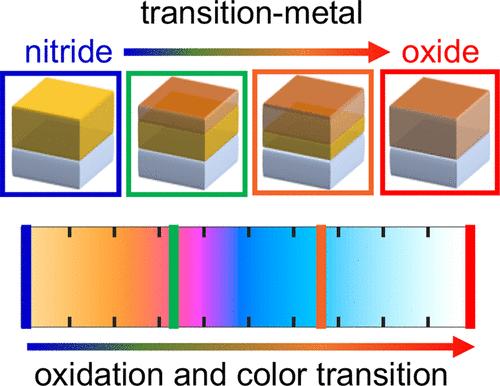高温结构色用过渡金属氮化物
IF 8.2
2区 材料科学
Q1 MATERIALS SCIENCE, MULTIDISCIPLINARY
引用次数: 0
摘要
过渡金属氮化物(TMNs),如氮化铪(HfN),氮化钛(TiN)和氮化锆(ZrN),已经成为光子学和等离子体学中非常有前途的材料,由于其光学特性可与传统等离子体材料(如Ag和Ag)相媲美,具有显着的热稳定性和化学稳定性,引起了人们的极大兴趣。虽然TMNs具有较高的体熔点和令人印象深刻的抗降解性,但缩小到纳米尺寸和暴露于高温氧化环境对其光学性质的影响仍未得到充分研究。在这项工作中,我们建立了一个综合的实验框架,结合原位光学表征和非原位表面分析来探索600°C下暴露于氧气的TMNs的行为。这种氧化过程使TMNs中的逐渐颜色转变成为可能,从而为高温结构色印刷的创新应用开辟了道路。我们进一步研究了氧化铝(Al2O3)作为一种保护涂层,可以有效地防止氧化并保持高达830°C的光学行为,使这些涂层适用于苛刻的热环境。研究结果强调了TMNs在下一代高温光子器件中的潜力,在具有挑战性的环境中平衡光学性能和耐用性。本文章由计算机程序翻译,如有差异,请以英文原文为准。

Transition-Metal Nitrides for High-Temperature Structural Colors
Transition-metal nitrides (TMNs), such as hafnium nitride (HfN), titanium nitride (TiN), and zirconium nitride (ZrN), have emerged as highly promising materials in photonics and plasmonics, drawing significant interest due to their optical properties comparable to those of conventional plasmonic materials like Ag and Ag, with remarkable thermal and chemical stability. While TMNs possess high bulk melting points and impressive resistance to degradation, the impact of scaling down to nanoscale dimensions and exposure to oxidizing environments under high temperatures on their optical properties remains largely underexplored. In this work, we establish a comprehensive experimental framework combining in situ optical characterization and ex situ surface analysis to explore the behavior of TMNs at 600 °C with exposure to oxygen. This oxidation process enables gradual color transitions in TMNs, thereby opening pathways for innovative applications in high-temperature structural color for printing. We further investigate aluminum oxide (Al2O3) as a protective coating to effectively prevent oxidation and preserve optical behaviors up to 830 °C, making these coatings suitable for applications in demanding thermal environments. The findings highlight TMNs’ potential in next-generation high-temperature photonic devices, balancing optical performance and durability in challenging environments.
求助全文
通过发布文献求助,成功后即可免费获取论文全文。
去求助
来源期刊

ACS Applied Materials & Interfaces
工程技术-材料科学:综合
CiteScore
16.00
自引率
6.30%
发文量
4978
审稿时长
1.8 months
期刊介绍:
ACS Applied Materials & Interfaces is a leading interdisciplinary journal that brings together chemists, engineers, physicists, and biologists to explore the development and utilization of newly-discovered materials and interfacial processes for specific applications. Our journal has experienced remarkable growth since its establishment in 2009, both in terms of the number of articles published and the impact of the research showcased. We are proud to foster a truly global community, with the majority of published articles originating from outside the United States, reflecting the rapid growth of applied research worldwide.
 求助内容:
求助内容: 应助结果提醒方式:
应助结果提醒方式:


